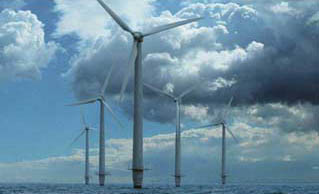Feb 28 2005
James Manwell, a research associate professor in the Mechanical and Industrial Engineering Department of University of Massachusetts Amherst, jokingly calls his current research into offshore deep-water wind farms the “Not Nantucket Sound Project,” referring to the controversy stirred up by a proposed shallow-water wind farm in the waters between Cape Cod and Nantucket.

Manwell and his research colleagues on campus and at MIT and Woods Hole Oceanographic Institution are sharing a nearly $600,000, one-year pilot grant to begin the design of the next generation of offshore wind turbines that will not only avoid the controversy dogging the Nantucket Sound proposal, but tap into a vast amount of wind energy.
“If you’re just fighting over water that’s only 60 feet deep,” says Manwell, “there’s a significant but not huge amount of energy. But deep water has the potential for wind farms going out to 200 miles. That would mean an enormous energy potential.”
One essential debate that the pilot project will deal with is whether to make wind turbines float or make them bottom-mounted, as in oil rigs. The planning will also deal with optimizing layouts for offshore wind farms by determining the most favorable water depth, distance from shore, spacing between turbines and wind-wave environment. To help sort out these issues, researchers will collect data with remote-sensing “SODAR,” which Manwell describes as “conceptually similar to sonar or radar.” There will also be extensive computer modeling of wind-farm scenarios, including simulations of positive impacts wind farms would have on the utility grid and air pollution.
The Offshore Wind Energy Collaborative, as the research consortium is called, is being funded by the Massachusetts Technical Collaborative, the General Electric Wind Energy Division and the U.S. Department of Energy.
http://www.umass.edu/